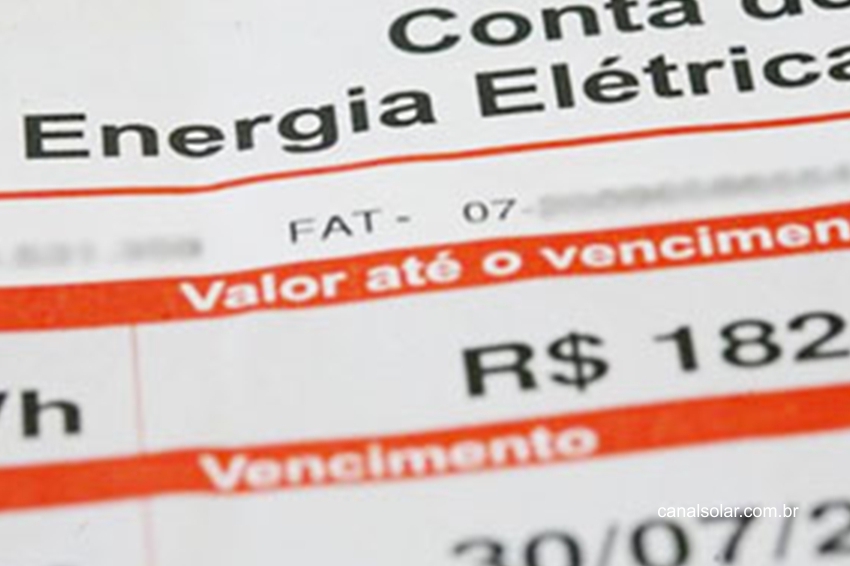The complexity of the Brazilian electricity pricing system results in invoices that are difficult to understand and analyze.
The objective of this article is to show how to extract important information from these invoices for the correct dimensioning of a photovoltaic system connected to the grid.
The electricity bill is the official document issued by the energy distributor to the consumer, with the aim of informing the costs involved with the supply of electricity.
Such costs include TE (energy tariff), TUSD (system connection and usage fee), public lighting, taxes and sectoral charges. The energy bill is the starting point for sizing a photovoltaic system.
O PRODIST Module 11 (Electric Energy Distribution Procedures) of ANEEL (National Electric Energy Agency) defines the mandatory information that must be presented on the invoice, such as consumer identification and address, grouping (A or B), type of connection (single-phase, two-phase or three-phase), energy consumed, contracted demand, measured demand, taxes and billing history.
There is no common template or model adopted by different energy distributors in the country, but in general, invoices have a common presentation standard.
Group B consumers (conventional tariff)
This category includes homes, schools, stores and small industries. Consumers with these characteristics have only one tariff value, regardless of the consumption time (peak or off-peak). They also have a monomial tariff, that is, they only pay for consumption and have no contracted demand.
It is possible to conclude from the invoice that this is a Group B consumer [2], with Conventional tariff [1], three-phase connection [3] with voltage at 127 V (phase-neutral) / 220 V (phase-phase) [4]. The recorded consumption is 717 kWh [5], paying a tariff of R$ 0.54 for each kWh (with taxes) [6], including a value of R$ 49.76 for the Public Lighting fee [8]. The taxes paid [9] are ICMS (25%), COFINS (4.99%) AND PIS (1.08%).
Energy bills also have a monthly consumption history, and it is based on the average consumption of the last 12 months that the sizing of the photovoltaic system is made.
Consumers in Group B do not have contracted demand, but have a minimum availability rate. This fee is charged even if there is no energy consumption by the UC (consumer unit), and its purpose is to enable the distributor to bear the costs of operating and maintaining the distribution network. The value of the minimum fee depends on the type of connection between the connection point and the utility company (energy input standard), according to the table.
| Connection type |
Minimum availability rate |
| Single-phase (phase and neutral) or two-phase two-wire (2 phases) | Energy tariff x 30 kWh |
| Two-phase three-wire (2 phases and neutral) | Energy tariff x 50 kWh |
| Three-phase four-wire (3 phases and neutral) | Energy tariff x 100 kWh |
The minimum availability fee is only charged if the consumer does not reach the minimum consumption: 30 kWh, 50 kWh or 100 kWh – according to the table. If the consumer has consumption equal to or greater than the minimum consumption, he or she will only pay for consumption.
To illustrate how and when the minimum availability fee is charged, we will consider the consumer in the bill analyzed above, who has a three-phase connection to three wires and pays a tariff of R$ 0.54 per kWh:
Situation 1: Consumption less than 100 kWh in a given month
As the actual consumption in the month was lower than the minimum consumption (100 kWh), the consumer will pay the minimum availability fee. Example: consumption of 20 kWh, you would pay R$ 54.00 (0.54 [R$/kWh] x 100 [kWh]).
Situation 2: Consumption greater than 100 kWh in a given month
When the actual consumption in the month was greater than the minimum consumption, the consumer will only pay for the energy consumed. Example: consumption of 350 kWh, you would pay R$ 189.00 (0.54 [R$/kWh] x 350 [kWh]).
In addition to paying for consumption, the customer will also pay for the CIP (Public Lighting Contribution) or COSIP (Contribution for the cost of the Public Lighting service) and also for the additional tariff flags (yellow or red).
In summary, the information necessary to size the photovoltaic system for this consumer is:
| Grouping | Group B |
| Tariff Modality | Conventional |
| Connection type | Three-phase |
| Minimum consumption | 100 kWh |
| Minimum Availability Rate | R$ 54.00 |
| Connection Voltage | 127V / 220V |
| Energy Tariff with Taxes | R$ 0.54 |
| Average monthly consumption (last 12 months) | 635 kWh |
Group A consumers (hourly-seasonal tariff)
This category includes medium and large industries, hospitals, universities, shopping centers and large businesses.
Consumers with these characteristics have tariffs with different values depending on the periods of the day in which consumption occurs, the so-called Peak and Off-peak periods.
Peak hours are characterized by the period of 3 consecutive hours with the highest network demand, generally between 6:00 pm and 9:00 pm on weekdays (Monday to Friday).
It is up to each concessionaire to define which 3-hour period will be peak time. They also have a binomial tariff, that is, in addition to paying for consumption, they also pay for contracted demand.
Contracted demand is a type of rent for the physical structure of the distribution network. It determines the maximum instantaneous power that can be consumed from the distribution network, and the energy distributor must guarantee this power continuously.
The contracted demand must be paid in full, whether or not it is used during the billing period.
If at a given moment the demand used is greater than the contracted amount, in addition to paying for the extra amount of overshoot, the consumer will also pay a fine proportional to the overrun.
As it is power and not energy, the contracted demand is given in kW (not kWh). The contracted demand can also be unique (green seasonal time) or variable according to the time of day (blue seasonal time) – a contracted demand for the Peak time and another for the Off-peak time.
Group A invoices contain a large amount of information, which makes their interpretation a little more complicated than Group B invoices. Let's look at the following energy invoice:
It is possible to conclude from the invoice that this is a consumer from GROUP A [1], with GREEN SEASONAL HOUR tariff [2], THREE-PHASE connection [3], at voltage of 13.8 kV [4] with CONTRACTED DEMAND of 240 kW [5], and the cost of each kW of contracted demand has a cost of R$ 14.68 [11]. The energy consumed during PEAK hours was 5,002 kWh [6] and the energy consumed during OFF PEAK hours was 60,908 kWh [7]. The total RATE (TE + TUSD) during PEAK hours was R$ 1.47 [9] for each kWh (including taxes), the total RATE (TE + TUSD) during OFF PEAK hours was R$ 0.30 [10] . The taxes paid [9] are ICMS (25%), COFINS (4.99%) and PIS (1.08%). The Consumer Unit (CU) number is 123456789 [7] which is the registration number with the distributor.
In summary, the information necessary to size the photovoltaic system for this consumer is:
| Grouping | A group |
| Tariff Modality | Green Seasonal Time |
| Connection type | Three-phase |
| Contracted Demand at Peak Hours | 240 kW |
| Contracted Demand during Off-peak hours | 240 kW |
| Connection Voltage | 13,800V |
| Ponta Fare with Taxes | R$ 1.474 |
| Fare at Fora Ponta with Taxes | R$ 0.306 |
| Average monthly consumption (last 12 months) | 58,598 kWh |





















One Response
Excellent article, congratulations.